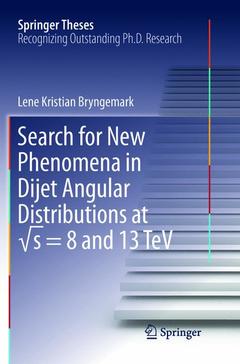Description
Search for New Phenomena in Dijet Angular Distributions at √s = 8 and 13 TeV, 1st ed. 2017
Springer Theses Series
Author: Bryngemark Lene Kristian
Language: English
Subject for Search for New Phenomena in Dijet Angular Distributions...:
Publication date: 06-2019
173 p. · 15.5x23.5 cm · Paperback
Approximative price 105.49 €
In Print (Delivery period: 15 days).
Add to cartPublication date: 01-2018
Support: Print on demand
Description
/li>Contents
/li>Comment
/li>
This thesis describes the use of the angular distributions of the most energetic dijets in data recorded by the ATLAS experiment, at CERN?s Large Hadron Collider (LHC), the goal of which is to search for phenomena beyond what the current theory of Particle Physics (the Standard Model) can describe. It also describes the deployment of the method used in ATLAS to correct for the distortions in jet energy measurements caused by additional proton?proton interactions.
The thesis provides a detailed introduction to understanding jets and dijet searches at the LHC. The experiments were carried out at two record collider centre-of-mass energies (8 and 13 TeV), probing smaller distances than ever before. Across a broad momentum transfer range, the proton constituents (quarks and gluons) display the same kinematical behaviour, and thus still appear to be point-like. Data are compared to predictions corrected for next-to-leading order quantum chromodynamics (NLO QCD) as well as electroweak effects, demonstrating excellent agreement. The results are subsequently used to set limits on parameters of suggested theoretical extensions to the Standard Model (SM), including the effective coupling and mass of a Dark Matter mediator.
Thesis Introduction.- The Standard Model and Beyond.-The Large Hadron Collider.- The Atlas Experiment.- Calorimetry.- Jet Finding.- Pile-up in Jets.- Dijet Measurements.- Signal Model Sample Generation.- Analysis of Angular Distributions at √s = 8 and 13 Tev.- Results.- Conclusions and Outlook.
Nominated as an outstanding Ph.D. thesis by the Lund University, Sweden and CERN, Geneva
Describes the first dijet angular distributions on 13 TeV data
Offers comparisons of data to standard model (SM) predictions with next-to-leading order quantum chromodynamics (NLO QCD) and electroweak corrections
Demonstrates the dijet mass independence of angular distributions at different centre-of-mass energies
Includes supplementary material: sn.pub/extras




